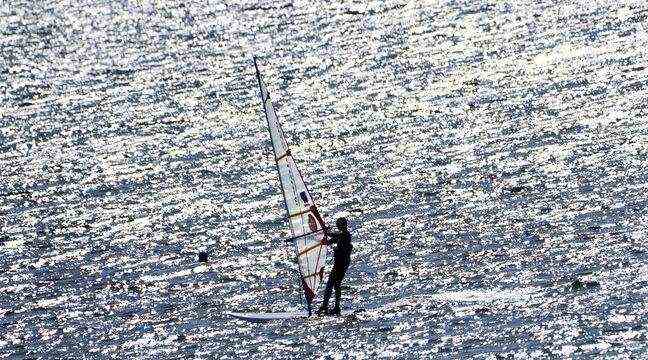A windsurfer stuck at sea rescued after 17 hours off Marseille. – Sebastien SALOM-GOMIS
When he decides to go to sea with his windsurfing board this afternoon at the end of March, Francis Moreau is far from imagining that he is about to experience a real ordeal. That day, off the coast of Marseille, the weather was radiant, the sea calm and the north-westerly wind moderate. But the 59-year-old school teacher says that after an hour of sailing, “the wind has died down, totally”. At only 300 meters from the coast, Francis nevertheless found himself stuck, then, “quite quickly”, began to drift out to sea.
After several attempts to set off again, a calf cramp and vain signs to boats in the distance, without a telephone, he resigned himself to waiting, sitting on his float, his legs in 13-degree water. At 7 pm, curfew obliges, the sea empties completely: “I said to myself that my wife was going to start to worry”.
Research launched at 8:30 p.m.
Indeed, his relatives give the alert. “Initially, we do an investigation and analysis work to locate the person,” explains Carine Buzaud, responsible for coordinating rescue operations at Cross Med (Regional Operational Center for Surveillance and Rescue of Mediterranean). The Cross asks relatives about the state of health of the missing person, his equipment, the color of his clothes, in an attempt to locate him.
When the frigate captain and pilot Thomas Ancelin was notified, around 8:30 p.m., six boats (firefighters and rescue associations) and a civil security helicopter were already looking for this teacher from the Carry-le-Rouet schools : “When we take off, we say to ourselves that with the cool temperatures and the night falling, we have to go fast”.
“I understood that they had stopped the research”
Despite “a beautiful moon with a lot of visibility”, nobody spots Francis Moreau. “If he had had even one lamp, he was located very quickly, but there it was a needle in a haystack”, regrets Thomas Ancelin, 35 rescues to his credit. The castaway sees a helicopter and the lights of the National Society for Rescue at Sea (SNSM) boat, but they do not see him. Around 3 o’clock, all the lights disappear: “I understood that they had stopped the research, I said to myself that I had to get out of there on my own”.
Despite his wetsuit, slippers and neoprene cap, he is “frozen”. He lies down on his board, the sail of which he has detached to try to swim to the coast, facing the swell. “I capsized several times, morale took a hit.” He tries to reach the Planier lighthouse, off the coast of Marseille, which he sees “without having the slightest idea of the distance”. His hands are scratched by the plank, his chin grated: “At one point, it occurred to me to drown myself to end this”.
But this enduring athlete calculates that he has “only five hours to go before daybreak”, and calms himself down with long breaths. When day finally breaks, a Falcon resumes the search. At the same time, fishermen come to his aid. Francis Moreau is saved.
A telephone, a “flash” lamp and a small mirror
Today, he deplores that “in windsurfing culture, safety is not taken into account”. Since his accident, he has equipped himself with an emergency beacon. For Carine Buzaud, this type of failed rescue is “horribly frustrating”. His advice: “Say where you are going, for how long, because relatives are the first warning vectors”, and “check your physical condition and equipment” before setting out to sea.
A phone in a waterproof pocket, a “flash” light for the night and a small mirror to be seen by day, can “greatly facilitate the rescue”, although they are not required. In 2020, Cross Med coordinated more than 2,500 operations in the Mediterranean over the summer period alone (+ 21% compared to 2019) and sees the 2021 season start “very, very strongly”.

